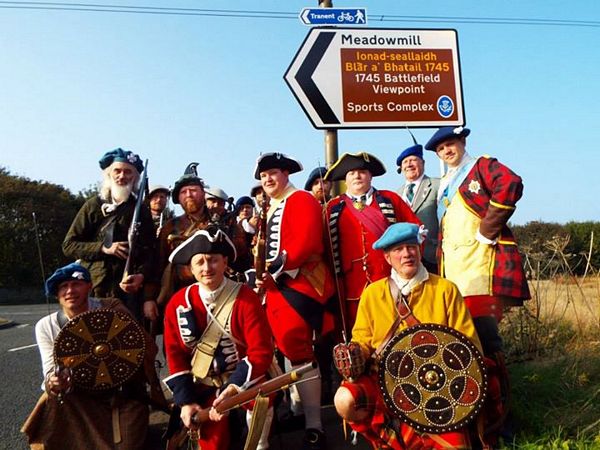But Yes, there is good news from the battle front ...
Bord na Gaidhlig fund 'corrected' battle site signage in Gaelic and English
It's taken a wee while, indeed since January 2010, but at last you wont be misdirected when looking for the site of the 1745 battle of Prestonpans.
Until last week, the Sports Complex sign at Meadowmill was complemented by a sign suggesting the battle site was there too. In fact of course it is the battle viewpoint at the top of the bing that is to be reached.
No longer. With the national support of the Minister for Scottish Languages who visited the Battle Trust earlier this year, and of Keith Scott in Transport and Susan Smith in Economic Development at East Lothian Council, and with funds from Bord na Gaidhlig, the signage is now correct. What lies atop the bing is the Battle Viewpoint [where the interpretation boards are also being refreshed and updated with support from Bord na Gaidhlig]. The statutory language parity of esteem enshrined under the Scottish Parliament's Gaelic Act 2005 has finally seen the light of day!

Lt General Sir John Cope and HRH Prince Charles, Prince of Wales, Prince Regent were both present along with Highlander and Redcoat re-enactors from the Czech Republic, The Netherlands, Scotland and England to enjoy this relevant addition to the Battle Trust's evolving interpretation of this epic battle on the 269th precise anniversary - September 21st.
___________________________________________________________________
[Ed. One doubting Thomas suggested many in the Prince's army did not speak Gaelic. At the time of the victory on September 21st the vast majority did. Afterwards as large numbers flocked to the Prince's colours with even more switching sides, the Gaelic speaking percentage did indeed decline somewhat but it always remained very significant throughout the march to Derby, the occupation of Glasgow, victory at Falkirk and eventual defeat at Culloden ... which is why the Trust has ensured these signs today honour that national language.
There are statistics in Allan I. Macinnes’s “Clanship, Commerce and the House of Stuart, 1603–1788”, p. 163. At Prestonpans Gaelic speakers provided about 2,430 of the Jacobite force of 2,580 i.e. 94 per cent. On the march into England Gaelic speakers provided 67 per cent of the force of 6,000. At Culloden Gaelic speakers provided about 67 per cent of the Jacobite force but only 33 per cent of prisoners and other reported survivors.]
Published Date: September 24th 2014
|





